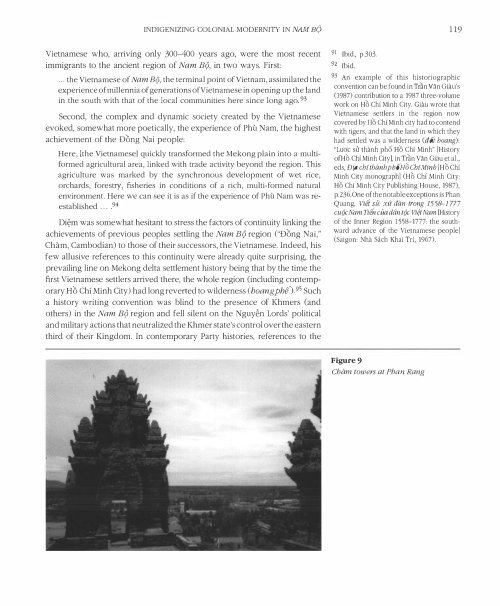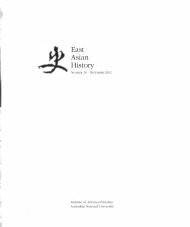(Philip Taylor) (PDF 3.1MB) - ANU
(Philip Taylor) (PDF 3.1MB) - ANU
(Philip Taylor) (PDF 3.1MB) - ANU
You also want an ePaper? Increase the reach of your titles
YUMPU automatically turns print PDFs into web optimized ePapers that Google loves.
INDIGENIZING COLONIAL MODERNITY IN NAM EO<br />
Vietnamese who, arriving only 300--400 years ago, were the most recent<br />
immigrants to the ancient region of Na m B¢, in two ways. First:<br />
... the Vietnamese of Nam BQ, the terminal point of Vietnam, assimilated the<br />
experience of millennia of generations of Vietnamese in opening up the land<br />
in the south with that of the local communities here since long ag0 93<br />
Second, the complex and dynamic society created by the Vietnamese<br />
evoked, somewhat more poetically, the experience of Phu Nam, the highest<br />
achievement of the D6ng Nai people:<br />
Here, [the Vietnamese] quickly transformed the Mekong plain into a multiformed<br />
agricultural area, linked with trade activity beyond the region. This<br />
agriculture was marked by the synchronous development of wet rice,<br />
orchards, forestry, fisheries in conditions of a rich, multi-formed natural<br />
environment. Here we can see it is as if the experience of Phu Nam was reestablished<br />
... 94<br />
Dim was somewhat hesitant to stress the factors of continuity linking the<br />
achievements of previous peoples settling the Na m B¢ region ("D6ng Nai,"<br />
Cham, Cambodian) to those of their successors, the Vietnamese. Indeed, his<br />
few allusive references to this continuity were already quite surprising, the<br />
prevailing line on Mekong delta settlement history being that by the time the<br />
first Vietnamese settlers arrived there, the whole region (including contemporary<br />
H6 Chi Minh City) had long reverted to wilderness (hoangphe) 95 Such<br />
a history writing convention was blind to the presence of Khmers (and<br />
others) in the Nam B¢ region and fell silent on the Nguyn Lords' political<br />
and military actions that neutralized the Khmer state's control over the eastern<br />
third of their Kingdom. In contemporary Party histories, references to the<br />
119<br />
91 Ibid., p.303.<br />
92 Ibid.<br />
93 An example of this historiographic<br />
convention can be found in Triln van GiilU's<br />
(987) contribution to a 1987 three-volume<br />
work on H6 Chi Minh City. GiilU wrote that<br />
Vietnamese settlers in the region now<br />
covered by H6 Chi Minh city had to contend<br />
with tigers, and that the land in which they<br />
had settled was a wilderness (ddt haang):<br />
"LuCie Slt thanh ph6 H6 Chi Minh" [History<br />
ofH6 Chi Minh City], in Triin Van Giau et al.,<br />
eds, Dfa chi thanh pM H 6 Chi Minh [H6 Chi<br />
Minh City monograph] (H6 Chi Minh City:<br />
H6 Chi Minh City Publishing House, 1987),<br />
p.236.0ne of the notable exceptions is Phan<br />
Quang, Viet nt: xu dan trang 1558-1 777<br />
cu¢C Nam Tifn ClKl dan t¢C Viqt Nam [History<br />
of the Inner Region 1558-1777: the southward<br />
advance of the Vietnamese people]<br />
(Saigon: Nha Sach Khai Tri, 1967).<br />
Figure 9<br />
Cham towers at Phan Rang
















